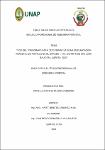| dc.contributor.advisor | Benites Sánchez, Abel Yafet | |
| dc.contributor.advisor | Baselly Villanueva, Juan Rodrigo | |
| dc.contributor.author | Muñoz Schrader, Ornella Lorena | |
| dc.date.accessioned | 2023-11-08T18:25:29Z | |
| dc.date.available | 2023-11-08T18:25:29Z | |
| dc.date.issued | 2023 | |
| dc.identifier.other | 630.208 M94 2023 | |
| dc.identifier.uri | https://hdl.handle.net/20.500.12737/9485 | |
| dc.description.abstract | The Peruvian Amazon has a high level of biodiversity and is the fifth most deforested region in the world; forest plantations are one measure to curb this problem. Generally, businessmen and timber producers select harvestable trees using visual methods based on external morphological characteristics, without taking into account the internal health of the individuals. Therefore, in order to promote and contribute to forestry development, the main objective of this study is to use the acoustic tomograph to determine the internal health of a forest plantation of Tornillo in El Dorado - INIA, District of San Juan Bautista, Loreto. The plantation is 24 years old and consists of 40 individuals of Cedrelinga cateniformis (Ducke) Ducke. The biometric structure and health (internal and external) were evaluated, using equipment such as Field-Map and acoustic tomograph. The dasometric variables showed high heterogeneity, with greater variability for basal area, total and commercial volume. Likewise, the plantation showed mean annual increases in DBH and total height of 2,1 cm/year and 1,2 m/year, respectively. The external part of the trees showed a 60% incidence of lichen damage and at the level of internal health the incidence of internal attack was 92,5%; the wood was minimally affected, located mainly in the basal and peripheral parts. Acoustic tomography, a non-destructive equipment, proved its effectiveness in the evaluation of the internal health of individual tornillo trees in forest plantations. | en_US |
| dc.description.abstract | La Amazonía peruana presenta alto nivel de biodiversidad y ocupa el quinto lugar en el mundo con mayor deforestación; las plantaciones forestales son una medida para frenar este problema. Generalmente, empresarios y productores madereros seleccionan árboles aprovechables utilizando métodos visuales basados en características morfológicas externas, sin tener en cuenta la sanidad interna de los individuos. Entonces para promover y contribuir con el desarrollo forestal el presente estudio tiene como objetivo principal, emplear el tomógrafo acústico para determinar la sanidad interna en una plantación forestal de Tornillo en el Dorado – INIA, Distrito de San Juan Bautista, Loreto. La plantación tiene 24 años de instalación y está conformado por 40 individuos de Cedrelinga cateniformis (Ducke) Ducke, Se evaluó la estructura biométrica y la sanidad (interna y externa), usándose equipos como el Field-Map y el tomógrafo acústico. Las variables dasométricas mostraron alta heterogeneidad, presentando mayor variabilidad para el área basal, volumen total y comercial. Así mismo, la plantación presentó incrementos medios anuales para el DAP y altura total de 2,1 cm/año y 1,2 m/año, respectivamente. La parte externa de los árboles presentaron una incidencia de 60 % por afectación de líquenes y a nivel de la sanidad interna la incidencia de fustes con ataque interno fue 92,5 %; la madera fue mínimamente afectada, ubicándose principalmente en la parte basal y periférica. Tomógrafo acústico, equipo no destructivo, demostró su efectividad en la evaluación de la sanidad interna de los individuos de tornillo en plantación forestal. | es_PE |
| dc.format | application/pdf | es_PE |
| dc.language.iso | spa | es_PE |
| dc.publisher | Universidad Nacional de la Amazonía Peruana | es_PE |
| dc.rights | info:eu-repo/semantics/openAccess | * |
| dc.rights.uri | https://creativecommons.org/licenses/by/4.0/ | * |
| dc.subject | Tomografía acústica | es_PE |
| dc.subject | Sanidad vegetal | es_PE |
| dc.subject | Tornillo | es_PE |
| dc.subject | Cedrelinga cateniformis | es_PE |
| dc.title | Uso del tomógrafo para determinar sanidad en plantación forestal de tornillo en el Dorado – INIA, distrito de San Juan Bautista, Loreto, 2022 | es_PE |
| dc.type | info:eu-repo/semantics/bachelorThesis | es_PE |
| thesis.degree.discipline | Ingeniería Forestal | es_PE |
| thesis.degree.grantor | Universidad Nacional de la Amazonía Peruana. Facultad de Ciencias Forestales | es_PE |
| thesis.degree.name | Ingeniero(a) Forestal | es_PE |
| dc.subject.ocde | https://purl.org/pe-repo/ocde/ford#4.01.02 | es_PE |
| renati.author.dni | 74464666 | |
| renati.advisor.orcid | https://orcid.org/0000-0001-6002-8492 | |
| renati.advisor.orcid | https://orcid.org/0000-0001-7795-7925 | |
| renati.advisor.dni | 05400149 | |
| renati.advisor.dni | 70453062 | |
| renati.type | https://purl.org/pe-repo/renati/type#tesis | es_PE |
| renati.discipline | 821046 | es_PE |
| renati.level | https://purl.org/pe-repo/renati/level#tituloProfesional | es_PE |
| renati.juror | Ríos Zumaeta, Richer | |
| renati.juror | Alva Ruiz, Jorge Elías | |
| renati.juror | Fachin Malaverri, Lizardo Manuel | |
| dc.publisher.country | PE | es_PE |





